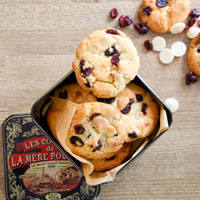A Few Tips for Shipping Baked Goods in the Mail
 Food items can be challenging to mail, since they’re classified as perishables, but a lot of baked goods travel well, so if you want to surprise a friend or family member with a box of homemade cookies or even a pie, go for it! Here are a few tips for shipping baked goods in the mail that may come in handy and make things easier for you.
Food items can be challenging to mail, since they’re classified as perishables, but a lot of baked goods travel well, so if you want to surprise a friend or family member with a box of homemade cookies or even a pie, go for it! Here are a few tips for shipping baked goods in the mail that may come in handy and make things easier for you.
Figure Out What You Can and Cannot Ship
The first thing you need to know is that international shipping has more restrictions than domestic shipping. Food items that can be shipped domestically not always can be mailed internationally, so make sure to check out the carrier’s restrictions and the import rules of the country of destination.
There are less restrictions when it comes to shipping baked goods domestically. However, we recommend against mailing baked goods that are too fragile or temperature-sensitive like crispy cookies, macarons, anything with pieces of chocolate in it (because chocolate can melt), cheesecake, delicate pies, frosted cakes, crusty and yeast-leavened bread.
The best baked goods to mail are those that are hard, sturdy, not prone to crumbling or melting, and can be wrapped individually. They include non-crumbly cookies, quick breads (banana bread, beer bread, cornbread, pumpkin bread, zucchini bread), muffins and unfrosted cupcakes, pound cake, fruit and nut pies, brownies, blondies and other dessert bars.
Package Your Baked Goods Safely
Shipping baked goods requires at least two containers: the inner container for the baked goods and the outer container for shipping. There are different containers you can use for baked goods: cardboard boxes, cookie tins, wooden boxes, Tupperware containers, etc. If you need to ship a frozen pie, use a Styrofoam container that will help maintain the required temperature. The shipping box for baked goods must be sturdy; we strongly recommend against reusing old shipping boxes in this case.
The process of packaging baked goods for shipping goes as follows:
- Let your baked goods cool before starting to pack. If they are still warm when you pack them, moisture will condense in the container, which can lead to spoilage.
- Wrap each baked good individually in food-grade plastic film, aluminum foil, parchment paper, a paper bag, or a zip lock bag.
- Carefully place the wrapped baked goods in the container.
- Fill any empty space in the container with crumpled or shredded paper, bubble wrap, or another shipping filler. If you’re shipping a frozen pie, don’t forget to add special gel packs to keep it frozen while in transit.
- Close the container and give it a gentle shake. If you feel jostling or hear rattling, reopen the container and add more cushioning.
- Close and tightly seal the container, place it inside the shipping box.
- Fill any empty space in the shipping box with packing peanuts or another cushioning material.
- Seal the shipping box securely with packing tape and mark your shipment as “Perishable” and, if necessary, “Fragile”.
Choose the Right Shipping Carrier
Like with any shipment, you want to strike the perfect balance between delivery time and shipping cost. The slowest delivery options are usually the cheapest, but you don’t want to go too slow when shipping baked goods and other perishables.
Private courier services like UPS and FedEx are usually a better option when you’re shipping frozen pies because time is of essence here. The USPS may be a more economical option when you’re shipping cookies that can survive an extra day or two of shipping. We suggest that you right down all your options and then use a shipping calculator to choose the optimal one.
Ship Your Package at the Right Time
If you don’t want to pay more for overnight or weekend delivery, ship baked goods early in the week, i.e. no later than on Wednesday, to make sure your package arrives on time and doesn’t get stuck in a sorting facility or post office over the weekend.